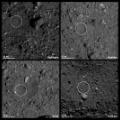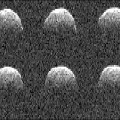
Photos: OSIRIS-REx will take a sample of asteroid Bennu and return it to Earth
An artist's concept of what the OSIRIS-REx spacecraft looks like as it orbits asteroid Bennu.
Hide Caption
10 of 13

Photos: OSIRIS-REx will take a sample of asteroid Bennu and return it to Earth
Pictured are the four candidate sample collection sites on asteroid Bennu selected by NASA's OSIRIS-REx mission. Site Nightingale (top left) is located in Bennu's northern hemisphere. Sites Kingfisher (top right) and Osprey (bottom left) are located in Bennu's equatorial region. Site Sandpiper (bottom right) is located in Bennu's southern hemisphere. Nightingale was ultimately chosen, and the others serve as backup sites.
Hide Caption
11 of 13

Photos: OSIRIS-REx will take a sample of asteroid Bennu and return it to Earth
The OSIRIS-REx spacecraft was built by Lockheed Martin Space Systems Company in Denver. It is 20.25 feet in length (6.2 meters) with its solar arrays deployed. Its width is 8 feet (2.43 meters) x 8 feet (2.43 meters). Its height is 10.33 feet (3.15 meters). It's powered by two solar panels that generate between 1,226 watts and 3,000 watts of energy. It has five instruments to explore asteroid Bennu and also has a robot arm to touch the asteroid long enough to collect a sample.
Hide Caption
12 of 13

Photos: OSIRIS-REx will take a sample of asteroid Bennu and return it to Earth
These radar images of asteroid Bennu were obtained by NASA's Deep Space Network antenna in Goldstone, California, on September 23, 1999. This is when they first discovered the asteroid.
Hide Caption
13 of 13
FOR BETTER QUALITY PHOTOS
Data from the spacecraft shows it touched down within 3 feet of the targeted location -- all while the spacecraft autonomously worked through commands sent ahead of time, using its advanced navigation system to help it land without assistance from Earth due to a 18.5-minute communication delay.

This graphic shows the spot where the spacecraft touched down on the asteroid.
Although all of the data sent back by the spacecraft so far indicates that everything happened as planned during the "Touch-and-Go" event, called TAG, it will take the mission teams about a week to determine how much of a sample was collected by the spacecraft.
The required amount for the sample is about 60 grams -- about a full-size candy bar -- but the capsule can hold up to 2 kilograms of material from the asteroid's surface.
Since launching in 2016, the mission has been filled with surprises and firsts, challenging its team to think on their feet as the asteroid revealed information that ultimately changed how NASA would attempt its first collection of a sample from an asteroid.

NASA mission successfully touched down on asteroid Bennu
Located more than 200 million miles from Earth, Bennu is a boulder-studded asteroid shaped like a spinning top and as tall as the Empire State Building. It's a "rubble pile" asteroid, which is a grouping of rocks held together by gravity rather than a single object.
The OSIRIS-REx mission stands for Origins, Spectral Interpretation, Resource Identification, Security-Regolith Explorer.
Rather than the sandy beach-like surface the mission team was expecting at first, it turns out that Bennu is covered in building-size boulders. It's also actively ejecting little rocks, pebbles and particles into space -- as first witnessed by the spacecraft's cameras soon after arriving at the asteroid in December 2018.
The spacecraft orbited the asteroid for nearly two years, observing it in detail. This resulted in the closest orbit for a spacecraft around an object, setting a Guinness World Record. It's also the smallest body to be orbited by a NASA spacecraft. And Bennu has now been mapped in greater detail than our own moon or any other celestial body in our solar system.
Due to the rocky nature of the asteroid, which could have spelled doom for the spacecraft attempting to collect a sample from it, the team had to pick its collection site carefully and shrink the landing site to one-tenth of its original size.
Imagine a van that can seat 15 passengers flying through space and approaching a rock that has the height of the Empire State Building and is rapidly rotating.
The landing site, called Nightingale, is 52 feet in diameter, about the size of a few parking spaces. This is where the spacecraft briefly touched the asteroid with its 11-foot robotic arm for just seconds on Wednesday. The touchdown and sample collection occurred about 4.5 hours after the spacecraft departed orbit around the asteroid and slowly descended.
Data has shown that the arm touched the surface of the asteroid and fired a burst of nitrogen gas, stirring up dust and pebbles that could be stowed by the arm's collection head.
After the collection, the spacecraft backed away from the asteroid to safety.
"This amazing first for NASA demonstrates how an incredible team from across the country came together and persevered through incredible challenges to expand the boundaries of knowledge," NASA Administrator Jim Bridenstine said in a statement after the event on Tuesday. "Our industry, academic, and international partners have made it possible to hold a piece of the most ancient solar system in our hands."
What's next
The mission team over the next week will use a camera on the spacecraft to take pictures of the collection head on the robotic arm to try and determine how much of a sample was collected.
The spacecraft will also perform a bit of a pirouette on Saturday, spinning about an axis that is perpendicular to its robotic arm, to determine the mass of the sample. The team will analyze this data and make a decision by October 30 if they have collected a sufficient sample.
"We will use the combination of data from TAG and the post-TAG images and mass measurement to assess our confidence that we have collected at least 60 grams of sample," said Rich Burns, OSIRIS-REx project manager at NASA's Goddard Space Flight Center in Greenbelt, Maryland, in a statement. "If our confidence is high, we'll make the decision to stow the sample on October 30."
Stowing the sample means that the mission team on Earth will send a command to the spacecraft to place the sample collection head in the sample return capsule, which is located inside the spacecraft's body.
Once everything is sealed, the spacecraft will prepare to depart Bennu in March 2021. This is when the asteroid will be aligned with Earth for a shorter trip home.
If the spacecraft did not collect enough of a sample, OSIRIS-REx will attempt another TAG at the backup Osprey landing site on the asteroid. This TAG event would occur on January 12, 2021
Once the spacecraft has a sufficient sample, it will travel back to Earth, parachuting into Utah's west desert on September 24, 2023.
What we can learn from a sample
There are more than a million known asteroids in our solar system, but Bennu was singled out for the OSIRIS-REx mission because it fit certain criteria regarding size, location and composition, according to Heather Enos, the mission's deputy principal investigator at the University of Arizona.
Bennu's sample won't be the first asteroid sample returned to Earth. The Japan Aerospace Exploration Agency , known as JAXA, collected a sample from the asteroid Ryugu during their Hayabusa2 mission. It should be returned to Earth in December.

2 different asteroids visited by spacecraft may have once been part of 1 larger asteroid
The two mission teams have collaborated closely throughout their missions and will be exchanging a portion of the samples collected from each asteroid. The NASA team hopes that its mission will collect a sample with "significantly more mass" because its sampling method is a little different from Hayabusa2's approach, according to NASA.
Enos hopes for a "completely full capsule" that represents Bennu's carbon-rich composition and hydrated minerals, both discovered based on observations and data sent back by OSIRIS-REx over the last two years. She also hopes that the sample includes a variety of sizes of material, including tiny grains and small pieces that have chipped off of the large yet weak and porous boulders on Bennu.
"Diversity is the key to get the most out of this sample," Enos said.
Scientists are already anticipating what they could learn from the returned sample. They don't expect to find life on the asteroid, which has been subjected to intense radiation, but the building blocks of life may be present in organic molecules and hydrated minerals on the asteroid.
Recently, scientists discovered that the fine material at the Nightingale site was only recently exposed to the space environment. This means that the material gathered by OSIRIS-REx will be some of the most pristine material on the asteroid.
"One of the prime goals of the mission is to understand the origins of the solar system and life on Earth, and the role asteroids may have played in delivering life-forming compounds on Earth," said Jamie Elsila, a research scientist at Goddard, during Monday's press conference.
Asteroids may have also delivered these compounds to other planets in the solar system.
Cutting-edge instruments in labs on Earth will be used to analyze portions of the sample. This is vastly preferable to studying meteorite fragments that land on Earth and are contaminated by our environment, she said.
However, the mission will archive 75% of the collected material. Much like samples from the Apollo 17 mission to the moon that were recently opened, scientists hope that future generations could learn more than we are currently able.
"This will allow people not yet born using techniques not yet invented to answer questions not yet asked," Elsila said. "But we're really looking forward to searching for these organic molecules, these building blocks, and determining their formation, evolution and distribution throughout the solar system. Then, we can figure out how life got started from those ingredients."




































